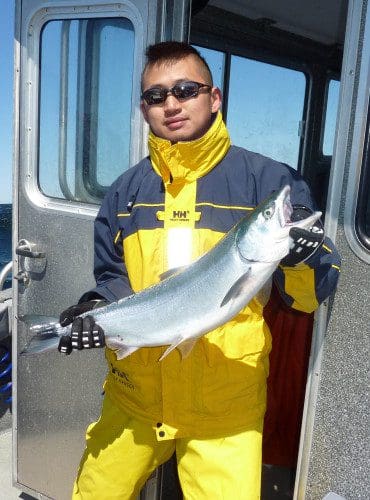 Names: Chum, dog, silver-brite
Names: Chum, dog, silver-brite
Range: Pacific rim from Korea to Oregon
Size: Usually 8 to 15 pounds, maximum 35 pounds
World Record: 35 pounds
Fishing Method: Mooching, jigging, and fly fishing
Range: Chum salmon spawn in rivers from Korea and Japan on the Asian side of the Pacific and from the Bering Sea to Tillamook Bay, Oregon on the North American side. They also spawn in rivers that empty into the Arctic Ocean, including McKenzie. As the polar ice recedes, Pacific salmon will have increasing opportunity to colonize Arctic Ocean drainages to the east. The Russians introduced chum salmon into the Barents Sea and these fish have now colonized some rivers in Norway.
Size: Chum average between 8 and 15 pounds, with a maximum size of 35 pounds. They are the second largest Pacific salmon. Chums vary tremendously in abundance from year to year and they also vary in size. The Japanese raise a lot of chums in hatcheries. These fish require just about zero care in fresh water after hatching which makes culturing chums relatively inexpensive.
Appearance: Bright chums are distinguished from other Pacific salmon by an absence of large black spots on the body and fins. They also have a relatively narrow caudal peduncle (that portion of the fish just forward of the tail) and dark tips on all fins except the dorsal. Mature chums are easily distinguished by the vertical bars on the sides. Anyone who has been around chums can throw out the book description for the most part. These fish have a hard to describe difference in coloration from other salmon, a blue-green shade. They also have a bigger eye, plus a smooth gum-line which is a dead giveaway.
Season: For the most part, spawning chum salmon claim the lower reaches of rivers, often shedding their eggs a mere stone’s through from the salt chuck. Maturing dog salmon return to their natal streams in autumn and winter, often times turning quite dark in saltwater. They enter the home river already ripe, and then spawn without much delay. Though this is the general rule with chums, some exceptions exist, the most glaring of which occurs on the Yukon River. There the chums travel 2,000 miles inland to spawn. These chums not only swim long distance, they do it fast, covering 25 to 30 miles a day.
Chum eggs hatch in the spring and the juveniles head out to sea without delay. The timing of their migration to the salt chuck places the youngsters in the sea at the time of the big spring plankton blooms. The principle feed for young of the year dog salmon is copepods and other tiny marine invertebrates.
Young chums spend their first few months near shore, and then they head for the wide open North Pacific. A large portion of North American chums concentrate in the Gulf of Alaska during the summer months. Chums spend anywhere from two to seven years moving about the ocean, feeding on a wide variety of invertebrates including euphausids (krill like animals), squids, amphipods, and crab larvae. Their appetite for smaller planktonic organisms makes them undependable biters for sports fishermen.
At one point, attempts at cross-breeding chums with chinooks were underway. The idea was a salmon that will requires no freshwater care, like a chum, but possesses the eating qualities of a chinook. Like most such projects, the “chumook” didn’t work out. It turns out, however, that chums are plenty valuable just the way they are in commercial fisheries throughout Alaska.
